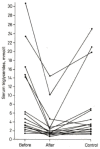Analyses and Declarations of Omega-3 Fatty Acids in Canned Seafood May Help to Quantify Their Dietary Intake
- PMID: 34578847
- PMCID: PMC8471815
- DOI: 10.3390/nu13092970
Analyses and Declarations of Omega-3 Fatty Acids in Canned Seafood May Help to Quantify Their Dietary Intake
Abstract
The American Heart Association (AHA) recently confirmed common recommendations of one to two fish dishes per week in order to prevent cardiovascular disease (CVD). Nevertheless, the natural fluctuations of lipids and fatty acids (FA) in processed seafood caught little public attention. Moreover, consumers of unprocessed seafood in general do not know how much omega-3 fatty acids (omega-3 FA) within servings they actually ingest. The few studies published until today considering this aspect have been re-evaluated in today's context. They included four observational studies with canned fatty coldwater fish (mackerel and herring from the same region, season, producer and research group). Their outcomes were similar to those conducted in the following years using supplements. Cans containing seafood (especially fatty coldwater fish) with declared content of omega-3 FA are ready-to-use products. Human studies have shown a higher bioavailability of omega-3 FA by joint uptake of fat. Canned fatty coldwater fish contain omega-3 FA plus plenty of fat in one and the same foodstuff. That suggests a new dietary paradigm with mixed concepts including several sources with declared content of omega-3 FA for reducing the cardiovascular risk and other acknowledged indications.
Keywords: CVD; canned seafood; coldwater fish; declarations of quantity; mixed concepts; omega-3 fatty acids; regional and seasonal variations of fatty acids.
Conflict of interest statement
The authors declare no conflict of interest.
Figures



Similar articles
-
Omega-3 fatty acids in Hawaii seafood.Hawaii Med J. 1994 May;53(5):142-5. Hawaii Med J. 1994. PMID: 8050896
-
ω-3 Fatty Acids and Cardiovascular Diseases: Effects, Mechanisms and Dietary Relevance.Int J Mol Sci. 2015 Sep 18;16(9):22636-61. doi: 10.3390/ijms160922636. Int J Mol Sci. 2015. PMID: 26393581 Free PMC article. Review.
-
U.S. adults are not meeting recommended levels for fish and omega-3 fatty acid intake: results of an analysis using observational data from NHANES 2003-2008.Nutr J. 2014 Apr 2;13:31. doi: 10.1186/1475-2891-13-31. Nutr J. 2014. PMID: 24694001 Free PMC article.
-
Readily available sources of long-chain omega-3 oils: is farmed Australian seafood a better source of the good oil than wild-caught seafood?Nutrients. 2014 Mar 11;6(3):1063-79. doi: 10.3390/nu6031063. Nutrients. 2014. PMID: 24618601 Free PMC article.
-
Omega-6 (n-6) and omega-3 (n-3) fatty acids in tilapia and human health: a review.Int J Food Sci Nutr. 2009;60 Suppl 5:203-11. doi: 10.1080/09637480903140503. Int J Food Sci Nutr. 2009. PMID: 19757249 Review.
Cited by
-
Effect of Previous Frozen Storage, Canning Process and Packing Medium on the Fatty Acid Composition of Canned Mackerel.Mar Drugs. 2022 Oct 25;20(11):666. doi: 10.3390/md20110666. Mar Drugs. 2022. PMID: 36354989 Free PMC article.
-
The Omega-3 Index Response to an 8 Week Randomized Intervention Containing Three Fatty Fish Meals Per Week Is Influenced by Adiposity in Overweight to Obese Women.Front Nutr. 2022 Feb 4;9:810003. doi: 10.3389/fnut.2022.810003. eCollection 2022. Front Nutr. 2022. PMID: 35187036 Free PMC article.
-
A Review on Marine Microbial Docosahexaenoic Acid Production Through Circular Economy, Fermentation Engineering, and Antioxidant Technology.Mar Drugs. 2025 Jun 16;23(6):256. doi: 10.3390/md23060256. Mar Drugs. 2025. PMID: 40559665 Free PMC article. Review.
References
Publication types
MeSH terms
Substances
LinkOut - more resources
Full Text Sources
Medical

